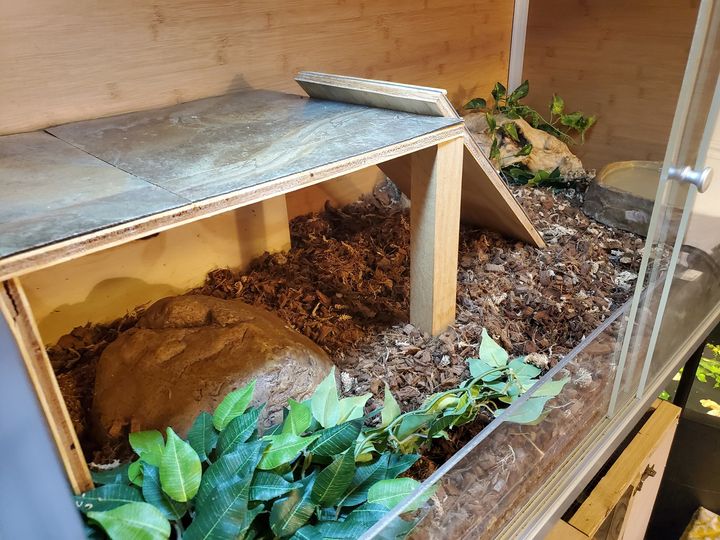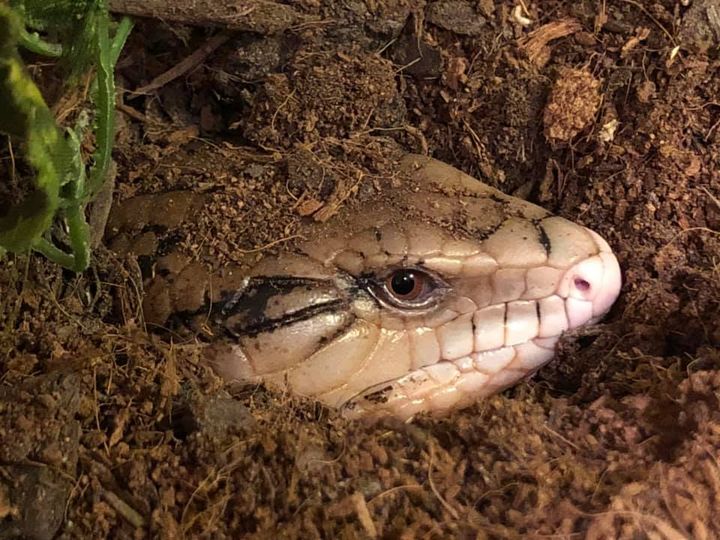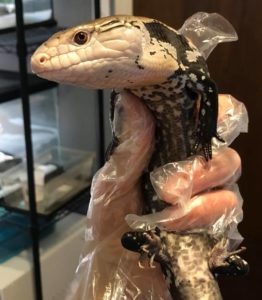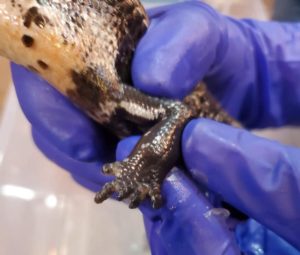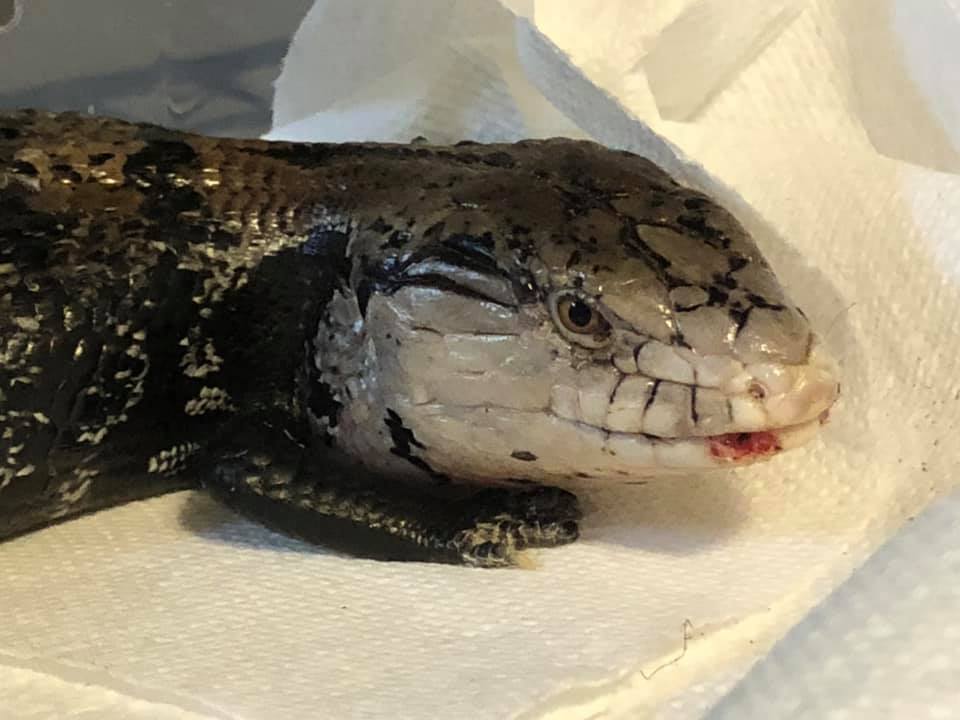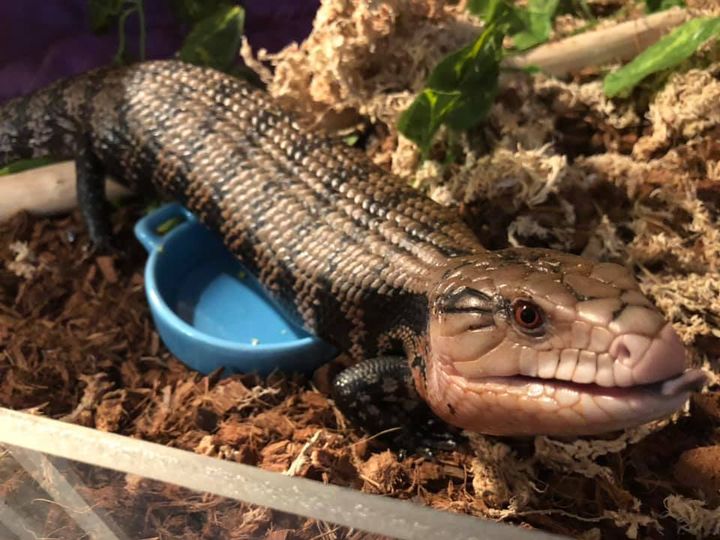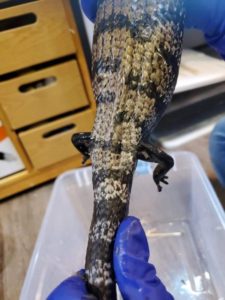Source: Blue Tongue Skink – BeWild Reptile Rescue
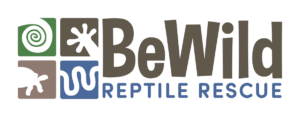
INDONESIAN BLUE TONGUE SKINK
Species name : Tiliqua gigas
Lifespan : 20-30 years
Origin : Indonesia and New Guinea
Adult size : 18-24”
Caging
Ideally, we recommend a 4’ x 2’ x 2’ enclosure for an adult blue tongue skink. A 40 gallon enclosure can work temporarily or for a smaller individual, but large adult blue tongues do best in at least 75 gallon enclosures. Glass enclosures and PVC enclosures both work for these lizards, but personally we prefer PVC enclosures as they hold humidity better for this rainforest species. If you use a glass enclosure, you can modify it to keep better humidity by misting more frequently, using a water-retaining substrate, and covering up part of the screen top with thick plastic or foil.
Our skink’s former enclosure, a 4x2 Zen Habitat.
Decor
Blue tongues enjoy a variety of decor to hide in and climb on. They definitely benefit from having a secure hide box, and we like to offer additional driftwood or corkbark structures as well as fake plants to provide cover. Blue tongues can be kept in a bioactive environment, but some of them can be quite destructive and heavy-bodied so it may be difficult for plants to stay alive. They also enjoy digging in substrate and will uproot most live plants.
Humidity
Indonesian subspecies need a higher humidity between 60-80%. For Halmaheras specifically, 80-100% humidity is recommended.
Substrate
Most blue tongue skink care sheets focus on Australian species such as Northerns, which have a SIGNIFICANTLY different humidity requirement. With Indonesian subspecies such as Meraukes, Irian Jayas, and Halmaheras, they need a humid enclosure with water-retaining substrate. We have used a variety of substrates with Indonesians, including cypress mulch (Forest Floor), ReptiChip, and organic potting soil. We do NOT recommend using coconut coir/Eco Earth on its own, as we have seen blue tongues with coir stuck in their eyes and mouth. Additionally, when coconut coir dries out, it becomes very dusty. However, we do like to use coconut coir as part of a mixture. We will often create a humid substrate mix with sphagnum moss, coconut coir, and ReptiChip.
Our skink’s current 4x2 PVC enclosure with added enrichment.
Our BTS, Arthur, burrowing in his substrate.
Heating
We prefer to use regular basking lamps for blue tongue skinks, as they do bask and this provides a good hot spot of about 95F. Ambient temperature in the cage should range from 75-80F. A ceramic heat emitter may be used at night if your house temperatures drop below 65F. A night-time drop in temperatures is beneficial for their metabolism.
We have also used under-tank heat pads with thermostats for certain medical cases and these work well for maintaining a gradient. Many skink breeders use UTHs in tubs or racks and they are safe and effective when used with a thermostat. We feel that basking lamps provide good enrichment for skinks and prefer them for long-term use.
Lighting
As stated above, we do recommend a basking light for heat and enrichment. We do not recommend any colored lights such as red or blue bulbs. UVB light is debated with this species. It does not seem to be as crucial for skinks as it is with other lizard species such as bearded dragons and chameleons. We have never received a skink with metabolic bone disease and do not see calcium deficiencies commonly with this species. We have kept skinks both with and without UVB light and have not noticed any discernible difference with health or temperament. It is likely that blue tongue skinks can synthesize the necessary D3 with dietary sources. If you do decide to use a UVB light, we recommend a lower percentage such as a 5% bulb.
Arthur doing a little basking!
A stunning BTS that was surrendered to us.
Diet
Blue tongue skinks are omnivorous lizards. We feed adults 2-4 times a week depending on size and age, and juveniles 6-7 times a week. Juveniles should have about 60-70% protein and 30-40% vegetation, while we recommend about 30-40% protein and 60-70% vegetation for adults. Blue tongue skinks are prone to obesity and this can lead to serious health issues, so we recommend monitoring their body condition and adjusting their diet accordingly.
The key to a blue tongue skink diet is variety. Offer a wide variety of both protein sources and vegetation. For protein, we cycle between live insects (dubia roaches, superworms, hornworms), canned/frozen snails, boiled chicken or quail eggs, Repashy Bluey Buffet, cooked chicken or turkey, and high-quality wet dog food. We mostly use the Bluey Buffet and wet dog food as they have better vitamin profiles, but variety is best. You can occasionally offer a small pre-killed pinky mouse, but we recommend limiting these as they are high in fat.
For vegetation, we limit fruit as it is high in sugar. We offer greens such as turnip greens, escarole, collards, dandelion greens, mustard greens, kale, arugula, and radicchio, and vegetables such as butternut squash, acorn squash, yellow squash, zucchini, carrot, bell pepper, and green beans. Popular fruits include raspberries, blackberries, blueberries, apples, pears, mangos, papayas, and melon. Skinks are not as big of a fan of vegetables and greens as they are of protein and fruit, so we chop up the vegetation and mix it all together with the protein, fruit, and supplements. This way, they cannot pick out their favorite pieces and ignore the vegetables.
Supplementation
Use calcium with D3 1-2 times a week and a multivitamin every 1-2 weeks.
Water
Use a large water dish, which will increase humidity in the enclosure. We like to give skinks the option to soak if they wish.
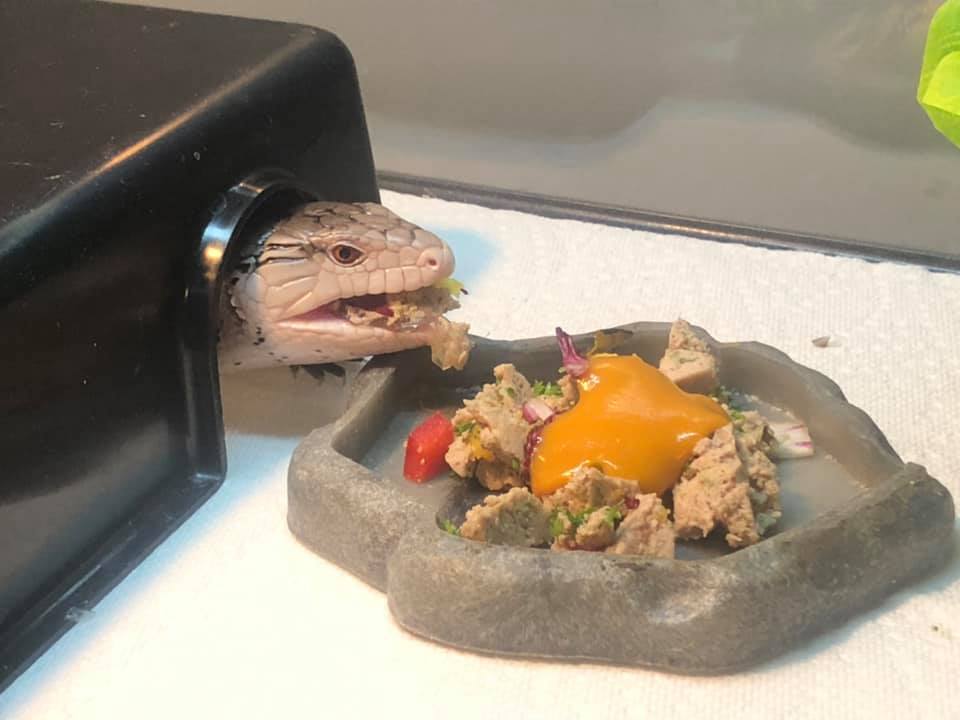
One of our skinks enjoying some dog food mixed with greens and pumpkin puree.

Arthur snacking on a quail egg.
Things You Should NOT Do
Use aspen, pine, or cedar shavings: We don’t recommend wood shavings in general as they easily mold when in a higher-humidity setup. Aspen is safe for Northern blue tongue skinks, but pine or cedar should never be used due to toxic phenols in the wood.
Use a red heat lamp: Reptiles CAN see red light and this will disturb their sleeping cycles. If you need additional heat at night, use a ceramic heat emitter.
Use a heat rock: While many pet stores will try to sell you a heat rock, they are extremely dangerous. Do not use them for any animal. Heat rocks are not well regulated and can reach temperatures high enough to severely burn your animal.
Cohabitate : Blue tongue skinks are not social animals and should never be housed with another skink. They can, and often will, show aggression towards each other, including nipping toes and tails. This can lead to severe injuries and infections. Blue tongue skinks should always be housed singly.
Fennel is a bearded dragon that was surrendered to BeWild with severe burns caused by a heat rock.
Common Health Issues
Burns: Burns are possible with unregulated heat pats (those WITHOUT thermostats), all heat rocks, and when the basking lights are too close to the basking spot. Make sure that your bulb has the correct wattage and always check the temperature with a good thermometer or infrared temperature gun. Do not use the stick-on thermometers, as they are inaccurate and will only measure the temperature on the glass side. Use a temperature gun or digital thermometer with a probe to measure the basking spot directly. If your skink does suffer a burn, seek veterinary attention immediately to assess the severity of the burn and treat it properly.
Dysecdysis/Retained Shed: This is very common with Indonesian blue tongue skinks, as they are often kept in low humidity enclosures. Stuck shed can accumulate around the toes and cause them to become necrotic and fall off. It can also cause secondary bacterial infections, so stuck shed can quickly become serious if not removed and treated.
A surrendered BTS with missing toes and infection due to retained shed.
Eye Infections : These are often caused when skinks are kept in low-humidity enclosures. When substrate dries out, it can get into the eyes and cause irritation and secondary infections. Eye infections can also be caused by unclean environments or water dishes. Be sure to maintain a clean environment and fresh water for your skink.
Metabolic Bone Disease : MBD, also known as nutritional secondary hyperparathyroidism, is possible with blue tongue skinks though not common if fed an appropriate diet. Signs of MBD include curved limbs, kinks in the spine or tail, lethargy, or paralysis in the hind limbs. To prevent MBD, provide a varied diet and offer supplemental calcium with D3 twice weekly. If your lizard is showing signs of MBD, see a veterinarian to assess the severity and start treatment. This may include oral liquid calcium and dietary correction. We do recommend using a UVB light if your lizard has MBD. MBD can be fatal if untreated.
This BTS was surrendered with lots of health issues, including an eye infection.
Mouth Rot: Mouth rot, or ulcerative stomatitis, is a condition where the mouth develops a bacterial infection. This can be due to a dirty water source or dirty enclosure, a wound in the mouth that becomes infected, or stuck shed around the face. Mouth rot can quickly become serious, as it is painful and will cause the skink to not want to eat. You should see a veterinarian, who will clean out the mouth with dilute chlorhexidine or betadine and start an antibiotic regimen.
Obesity : Blue tongue skinks are prone to obesity in captivity, especially if kept in small enclosures and fed a high-fat diet. Obesity can lead to hepatic lipidosis, also known as fatty liver disease. This is fatal if left untreated but is unfortunately often difficult to detect until it is too late. If your blue tongue skink is becoming overweight, feed fewer meals a week and offer more vegetation and less protein. Additionally, lower-fat protein items can replace the higher-fat items. Avoid high-fat items like dog food or eggs, and offer more insects. The Repashy Bluey Buffet diet is good as it mostly consists of black soldier fly larvae, a low-fat insect source.
Prolapse: Cloacal prolapses can happen in both male and female skinks, but male snakes can also have hemipenal prolapses. A prolapse is an emergency that should see a veterinarian immediately. If it is recent, sometimes the vet can push the prolapsed tissue back in and place a temporary suture, but advanced prolapses can become infected and necrotic. Some will require amputation. Prolapses can be caused by dehydration, fecal impaction, extreme parasite infestations, or can be from no noticeable cause.
This BTS has a lesion on its mouth due to stomatitis.
Our own BTS has been known to get a little chunky.
Parasites: Skinks can carry many different types of parasites, including pinworms, coccidia, spirochetes, and protozoans. This is VERY common in Indonesian blue tongue skinks, as many of them are wild-caught and imported from Indonesia. We do not advise purchasing a wild-caught reptile, as they are more likely to have health issues and are unsocialized and more difficult to tame. Always try to purchase a healthy blue tongue skink from a reputable breeder, or find a rescue that can perform a fecal on any rescued skinks. It is common for reptiles to have a small level of parasites, this is normal for their gut flora. However, when a reptile is sick or stressed, the parasites can take over and cause diarrhea, weight loss, regurgitation, and anorexia. This can become serious, so bring a fecal to your veterinarian if your skink is exhibiting the above signs.
This surrendered BTS was emaciated and found to have a high parasite load.
Respiratory Infection: Many skinks can develop respiratory infections due to incorrect temperatures, humidity, or unclean conditions. Signs include open mouth breathing, wheezing, sneezing, and discharge from the mouth or nostrils. Respiratory infections may be caused by bacteria, fungi, or viruses, but the most common are likely bacterial and these are usually treatable. Make sure to identify and rectify the husbandry conditions that may have contributed to the infection, and go to the veterinarian for antibiotics. In our experience, most cases will respond to a course of ceftazidime or a similar antibiotic, but some are caused by more resistant bacteria that can be identified and treated with a tracheal wash, culture, and sensitivity. Fungal and viral infections are typically more rare and do not have as effective treatments.
Scale Rot/Dermatitis: Skinks housed in enclosures that are too wet or not cleaned properly can get infections called scale rot or dermatitis. Your substrate should never be dripping wet or grow mold. Remove feces immediately and completely change substrate every 2-3 months. Signs of scale rot include blisters, ulcers, or scabs on the ventral area. Mild cases can usually be treated by placing the skink in a sterile paper towel setup, soaking in dilute chlorhexidine or betadine, and applying topical SSD cream or triple antibiotic ointment. However, we always recommend seeing a veterinarian to assess severity, as more severe cases may require wound debridement or systemic antibiotics.
SOURCES
GET IN TOUCH
- Durham, NC
- 919-442-8238
- info@bewildnc.org
We work exclusively with pet reptiles, amphibians, and invertebrates. If you find injured wildlife, please contact a licensed wildlife rehabilitator.
We are unable to take in yellow-bellied sliders and iguanas due to space restrictions. We are unable to take in red-eared sliders, as they are illegal to own in NC without a Restricted Species permit.
FOLLOW US
Facebook-f Instagram
